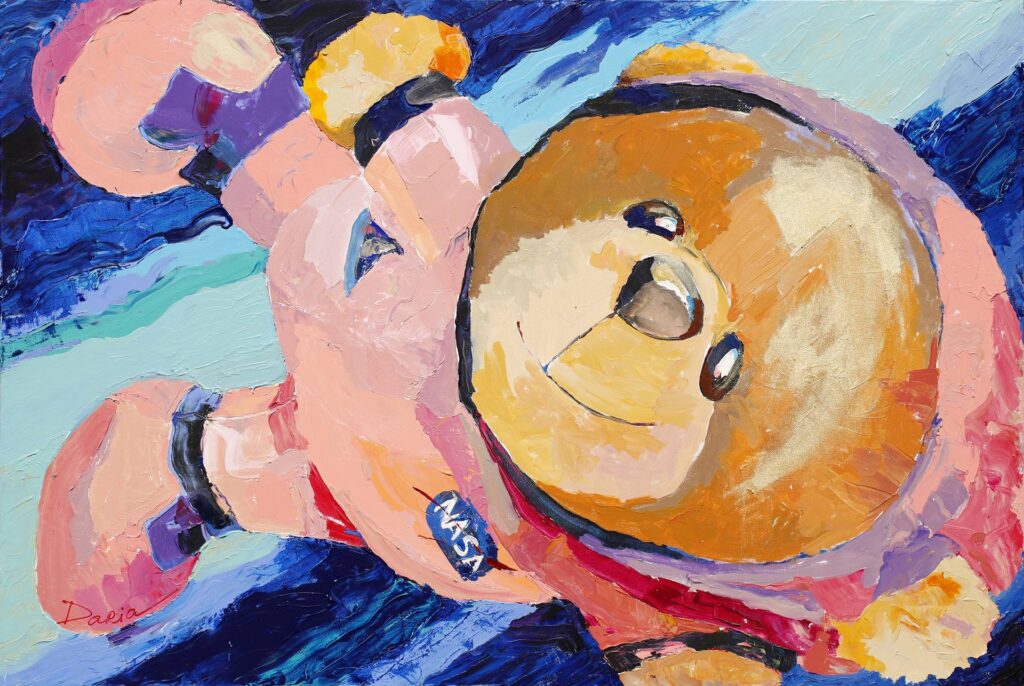Art has always carried the ability to reconcile paradoxes: the intimate and the universal, the whimsical and the profound, the earthly and the celestial. In Space Bear, a striking acrylic-on-canvas painting by Daria Bagrintseva, these polarities converge in an image that is as playful as it is contemplative.
Bagrintseva, a Russian-born artist working in the United States, has cultivated a practice that merges technical skill with imaginative exploration. Her work often navigates surrealist territory, where animals, humans, and cosmic elements intersect in ways that defy straightforward interpretation. Space Bear is a prime example—a painting that, at first glance, charms the viewer with its subject, yet gradually reveals layers of cultural commentary, symbolic resonance, and existential curiosity.
A Bear Among Stars
The bear is one of the oldest and most enduring symbols in art. From Paleolithic cave paintings to heraldic shields, from Native American totems to Russian folklore, the bear embodies strength, protection, and primal energy. In Bagrintseva’s Space Bear, however, this creature is no longer tethered to forests, rivers, or mountains. Instead, it floats in a cosmic environment, unmoored from the earthly domain and placed within the infinite expanse of outer space.
The juxtaposition is instantly striking: a terrestrial animal navigating an extraterrestrial setting. It suggests both absurdity and wonder, raising questions about adaptation, survival, and displacement. What happens when the most grounded of animals—symbol of hibernation, earth, and natural cycles—is thrust into the weightlessness of the cosmos?
Acrylic as Medium
Space Bear is executed in acrylic on canvas, a choice that emphasizes vibrancy and immediacy. Acrylic paints allow for saturation of color and quick layering—qualities well-suited for rendering both the density of the bear’s fur and the vast expanses of interstellar background.
Where oil might create subtle, smoky gradients, acrylics offer sharper contrasts, more akin to the luminous glow of celestial phenomena. Stars, planets, and nebulae emerge in bold clarity, while the bear itself—textured and tactile—anchors the scene. The medium becomes a dialogue between matter and immateriality: the solid density of paint embodying a weightless, boundless universe.
Skittish and Surrealism
On one level, Space Bear operates within the tradition of surrealism. Like Salvador Dalí’s melting clocks or René Magritte’s raining men in bowler hats, the image dislocates the viewer’s expectations. A bear in space is inherently illogical, but it is precisely this illogic that invites new meaning.
The surreal juxtaposition compels us to question the ordinary. If a bear can exist in space, what else is possible? The absurdity becomes liberating, reminding us that imagination need not conform to physical laws. The painting thus functions as an act of creative resistance against realism’s constraints.
Folklore, Myth, and Cosmic Symbolism
Beyond its surreal qualities, Space Bear resonates with deep symbolic traditions.
-
Russian and Slavic Culture: The bear has long been an unofficial symbol of Russia, representing strength, resilience, and national identity. For a Russian-born artist, placing the bear in space may allude to cultural displacement—an emblem of homeland wandering beyond familiar boundaries.
-
Cosmology and Myth: The constellation Ursa Major—the Great Bear—anchors human cosmological mapping. In many myths, the bear is immortalized as a starry figure in the night sky. Bagrintseva’s bear is not just in space; it continues this age-old symbolic ascension into the heavens.
-
American Resonance: Having relocated to the United States, Bagrintseva also situates the bear within American contexts, where the grizzly symbolizes wilderness and frontier spirit. The “space frontier” was famously invoked during the Space Race, making the bear in space an allegory of exploration and expansion.
Thus, Space Bear is not whimsical alone—it is a cosmopolitan emblem bridging folklore, myth, and modernity.
Anthropocene and Environmental Subtext
A more critical reading sees the painting as commentary on the Anthropocene—the era of human-driven planetary change. Bears today face habitat loss, climate change, and extinction pressures. To place a bear in space may symbolize displacement: as earth becomes inhospitable, even the most resilient creatures are imagined as seeking refuge among the stars.
This interpretation resonates with contemporary anxieties about colonizing other planets. If humans dream of escaping ecological collapse through space travel, Bagrintseva’s bear becomes a satirical stand-in, embodying both innocence and irony. What business does a bear have in space? Perhaps the same business humans imagine for themselves: survival beyond Earth.
Compositional Dynamics
In examining the painting’s structure, one notes a balance between figure and ground. The bear, central and commanding, draws immediate focus, while the surrounding cosmos stretches infinitely.
-
Color Palette: Deep blues, purples, and blacks dominate the background, punctuated by stars rendered in bright whites and yellows. The bear’s fur contrasts warmly—ochres, browns, and textured highlights—against this cosmic backdrop.
-
Perspective: The lack of ground or horizon destabilizes perspective, emphasizing weightlessness. The bear floats, as if suspended in a dream.
-
Movement: Depending on the composition, the bear may appear to stride, leap, or drift. Its gesture is ambiguous—neither fully predatory nor fully passive—suggesting exploration rather than aggression.
The overall effect is harmony between dislocation and stability: a grounded creature in an ungrounded environment.
The Bear as Alter Ego
In many artistic traditions, animals serve as alter egos or spirit guides. Space Bear can be read as an avatar for the artist herself—navigating between geographies, cultures, and disciplines. Having migrated from Russia to the United States, Bagrintseva lives between worlds. The bear in space becomes a metaphor for this liminal existence: powerful yet vulnerable, rooted yet displaced, searching for meaning in unfamiliar terrain.
Reception and Audience Engagement
Though whimsical, Space Bear carries accessibility that appeals to wide audiences. Children may delight in the image of an animal astronaut, while adults perceive deeper allegories. This dual readability expands the painting’s impact beyond elite art circles, aligning it with contemporary desires for art that is at once sophisticated and relatable.
Viewers encountering Space Bear in a gallery context are invited not merely to admire technique but to project their own interpretations. Is the bear heroic, comic, tragic, or spiritual? Its ambiguity becomes its strength, opening interpretive space for diverse audiences.
The Broader Context of Bagrintseva’s Work
Bagrintseva’s oeuvre often explores fantastical scenarios, blending realism with surreal invention. She employs animals as vessels of meaning, situating them in contexts that challenge expectations. Space Bear is consistent with this trajectory, yet it stands out for its cosmic scale and mythological resonance.
Placed alongside other works, Space Bear demonstrates Bagrintseva’s interest in hybridity—where East meets West, where folklore meets futurism, where play meets profundity.
Art Historical Connections
To situate Space Bear in broader art history, one might trace connections to:
-
Surrealism: Echoes of Dalí, Magritte, and Leonora Carrington, where animals occupy dreamlike spaces.
-
Pop Surrealism / Lowbrow Art: Similar to Mark Ryden or Camille Rose Garcia, Bagrintseva leverages whimsy to probe deeper meanings.
-
Environmental Art: Artists like Walton Ford use animals allegorically to comment on human intervention. Space Bear likewise critiques and celebrates human-animal interconnection.
-
Russian Avant-Garde: A lineage of bold experimentation, connecting to Malevich’s cosmic abstractions, where outer space becomes metaphor for liberation.
Why Space Bear Matters Today
In 2025, the resonance of Space Bear is particularly poignant. We live in an era defined by space exploration—private companies launching rockets, NASA planning Mars missions, telescopes revealing distant galaxies. At the same time, ecological crises on Earth force reconsiderations of survival and stewardship.
Bagrintseva’s painting embodies this paradox. It reminds us that in dreaming of the stars, we must not forget the creatures of the Earth. The bear’s cosmic voyage is fantastical, but it also raises ethical questions: What do we risk leaving behind in pursuit of the infinite?
Flow
Space Bear by Daria Bagrintseva is more than a surreal novelty. It is a profound meditation on displacement, identity, and cosmic imagination. Through acrylic paint on canvas, Bagrintseva creates a work that is visually arresting, symbolically rich, and culturally layered.
The bear, a timeless emblem of strength and protection, becomes untethered from the Earth, traversing galaxies as a surrogate for human longing, cultural hybridity, and ecological anxiety. Its presence in space is absurd, yet in its absurdity lies truth: we are all bears in space, navigating environments that challenge our nature, searching for meaning in a universe both wondrous and indifferent.
By merging folklore with futurism, personal narrative with universal symbolism, Bagrintseva secures Space Bear as a defining work of her artistic vision. It is a painting that refuses confinement, prowling across the boundaries of culture, myth, and imagination—forever a bear, forever in space.
No comments yet.








